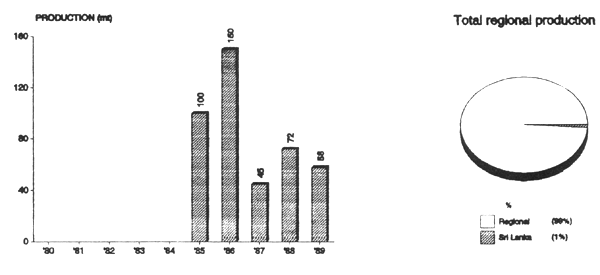
CRASSOSTREA spp.
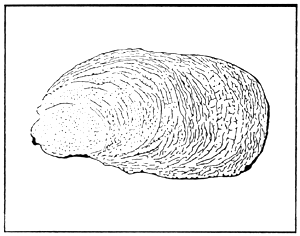
HISTORY
Although bivalve resources have been reported to be considerable in the coastal waters of Sri Lanka, bivalve culture is still at the experimental stage. At present, the National Aquatic Resources Agency (NARA) is the main governmental agency involved in applied research on mollusc culture in the country. A considerable number of edible oyster species has been identified by the agency, however research work is mostly concentrated on the large Crassostrea madrasensis and Crassostrea belcheri and on the smaller Saccostrea cucullata. Although this kind of food is not particularly popular among Sri Lankans, increasing numbers of fishing families involved in deep sea fishery turn to bivalves during the monsoon seasons and in some areas during peak tourist seasons. These protein-rich organisms are usually salted, dried and sold in the areas where the resources are plentiful. A series of on-going experiments on the culture of the above mentioned oyster species have shown that these organisms can be successfully cultured in numerous locations along the coastal waters of Sri Lanka. With the introduction of culture methods for the Indian large oyster (C. madrasensis) in 1982, this oyster has become particularly popular among people around the culture areas. No information has been made available on the distribution of natural oyster fisheries in Sri Lanka. It is believed that both C. madrasensis and C. cucullata are found throughout most of the Island's coasts. Oyster production figures in Sri Lanka are not available. It is presumed that the annual landings are relatively low due to the overall lack in popularity of oysters as a food item as well as the non-existent export market.
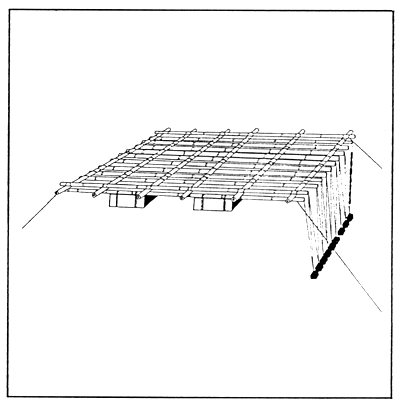
CULTURE PRACTICES
Relatively little information has been gathered on the spatfall seasons of edible oysters in Sri Lanka. According to recent information C. madrasensis and C. belcheri spawn throughout the year with two peaks, in November-January and June-August. Oyster spatfall has been monitored in a number of different intertidal areas along the coast of Sri Lanka, notably in Trincomalee Bay (north-eastern coast), Tangalle and Mirissa Fisheries Harbours (south coast) and Puttalam and Muttuwaran lagoons (north-western coast). The degree of spatfall varies considerably from area to area, mainly due to the size of the resident oyster population. It has also been suggested that poor collection in some sites may be due to the speed and direction of the water current as well as water turbidity. NARA is currently carrying out studies to determine suitable spatfall sites as well as to determine efficient methods for spatfall forecasting, so that cultches can be timely placed into the selected sites. Various oyster cultches have been tested in Sri Lanka, however desirable results have been achieved using coconut shells and windowpane oyster shells (Placuna placenta). Other cultches that have been tested are bamboo slits, asbestos, and rubber plates. It has been shown that highest numbers of spatfall occur on the surface layers of the water column, usually the upper three metres, particularly for C. madrasensis and C. belcheri. The oyster industry in Sri Lanka is currently facing all the typical constraints of establishing a culture system previously non-existent in the country. Very little information is available on the natural distribution of edible oysters, on spatfall seasons and suitable culture techniques. In addition, the lack of trained personnel is contributing to the slow growth of oyster culture. Although oysters are gaining popularity among small fishing communities, it is generally a food item not highly accepted. Culture experiments on C. madrasensis, which are being conducted by National Aquatic Resources Agency (NARA), are facing problems due to the limited supply of seed. The above situation is probably due to the lack of experience in seed collection by the personnel involved.
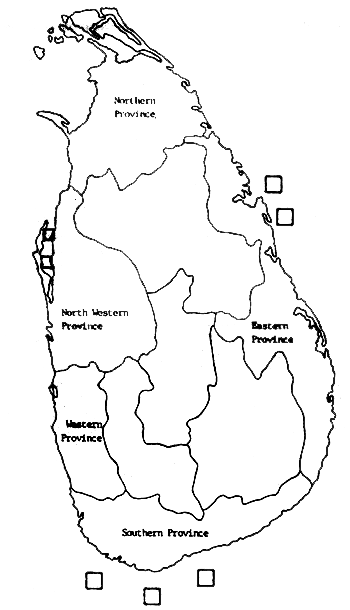
| STATUS | SPECIES |
|---|---|
| Crassostrea madrasensis and Crassostrea belcheri | |
| Source of seed | Wild |
| Culture method | Intertidal, raft |
| Yield/ha | NA |
| Marketing | Domestic |
| Production area | NA |
| Level of culture | Experimental |
| Major constraints | Lack of trained personnel; Poor seed supply; Marketing |

GRACILARIA spp.
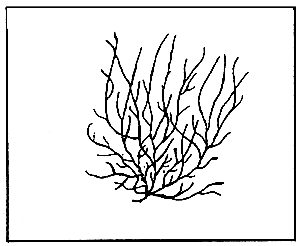
HISTORY
Gracilaria spp. have been exported from Sri Lanka since the 1800s. Exports to England of dried bleached “Ceylon moss” (Gracilaria spp.) was some 2,591 kg in 1831 and 6,818 kg in 1840. In 1930's Ceylon moss was reported from Gulf of Mannar, Puttalan Lagoon and from Ponparippu to Kallar. During that period people gathered it by means of hooks attached to lines. Seaweeds were dried in the sun and left overnight in the dew which is said to bleach it more effectively than the sun. During 1941–1944 it was estimated that 9,090 kg of seaweed was exported to India annually. After the war this export trade ceased but a few people in those areas continued to collect, bleach and supply small quantities to the local market. In 1950's export of Gracilaria picked up again because of the strong demand from Japan. In late 1960's due to a drop in quality standards of Sri Lanka Gracilaria exports, mostly due to the deliberate adulteration of the product, the trade was stopped for some time. In the 1970's about 50–100 tonnes of dried Gracilaria were again exported from Sri Lanka annually. The quantity exported in 1972 was around 50 tonnes. This increased to 100 tonnes in 1986. At present the Gracilaria industry is geared to the export of dried product without any processing. Experimental culture trials using vegetative fragmentation were first started in 1975, however these trials did not continue. In 1988, the National Aquatic Resources Agency with assistance from the Bay of Bengal Programme launched a project on the culture of Gracilaria edulis in one of the lagoons in Sri Lanka, which will hopefully lead to commercialization. In this project, culture trials are being tried by using carpospores as well as vegetative propagation.
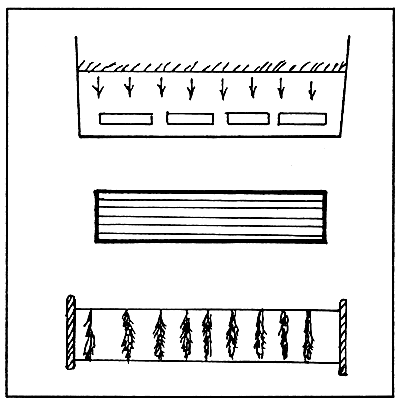
CULTURE PRACTICES
Commercial culture of Gracilaria in Sri Lanka does not exist and cultivation of seaweeds in general is still in the experimental stages. More attention has been given to Gracilaria species which faces a severe threat of exploitation due to the high demand for the export market. Indiscriminate harvesting of Gracilaria could lead to the complete extinction of the resources in the country. Experimental culture trials of Gracilaria edulis in Puttalam lagoon were first conducted in 1975, using the vegetative fragmentation method. In 1985 experimental culture trials of the same species were carried out in one of the lagoons in the northern part of Sri Lanka. Vegetative propagation techniques were tried in these experiments and it was found that the plants grew to a length of 12 cm in 8 weeks. Experimental culture uses the spore setting technique. Spore bearing female plants of Gracilaria are being collected from natural beds as seeding material. A spore setting facility should consist of two cement tanks. Seawater is then filled up to 25 cm high in each of the tanks. A net frame is then floated on top of the water level of each tank. Cystocarpic plants are then sprinkled on top of the net frame. Released spores from the cystocarp plants tend to sink and settle on the lines of the frames. These frames measure roughly 40 × 80 cm and are placed in the bottom of each tank. The plants start to grow on the lines themselves. The frames are then eventually transferred to a suitable lagoon for further growth. One kilogram (wet weight) of Gracilaria edulis can be harvested from a 5 metre line by using this method. Recent research studies and culture trials have revealed that fluctuations of environmental factors such as salinity, water current, tides and available nutrients can affect drastically the growth of the Gracilaria plants. Therefore, considerable efforts are being carried out to establish site selection criteria, as it is important to locate a suitable site before going into any commercial culture venture.

| STATUS | SPECIES |
|---|---|
| Gracilaria edulis | |
| Source of seed | Wild |
| Culture method | Open sea (vegetative propagation and spore setting) |
| Yield/ha | 5 kg/meter rope (wet wt) |
| Marketing | Domestic and export |
| Production area | NA |
| Level of culture | Experimental |
| Major constraints | Grazing; High salinity; Limited seed supply |
